从Client应用场景介绍IdentityServer4(四)
原文:从Client应用场景介绍IdentityServer4(四)
上节以对话形式,大概说了几种客户端授权模式的原理,这节重点介绍Hybrid模式在MVC下的使用。且为实现IdentityServer4从数据库获取User进行验证,并对Claim进行权限设置打下基础(第五节介绍)。
本节内容比较多,且涉及一、二节的内容,如有不懂,可先熟悉一、二节知识。
一、新建授权服务,命名为AuthServer
(1)新建Web API项目,不用配置HTTPS,不进行身份验证。
设置成控制台方式运行,端口设为5000。
安装IdentityServer4包
在Config.cs类中,添加如下代码:
public class Config
{ public static List<TestUser> GetUsers()
{
return new List<TestUser>
{
new TestUser
{
SubjectId = "1",
Username = "test",
Password = "123", Claims = new List<Claim>
{
new Claim("role", "user")
}
},
new TestUser
{
SubjectId = "2",
Username = "admin",
Password = "123", Claims = new List<Claim>
{
new Claim("role", "admin")
}
}
};
} public static IEnumerable<IdentityResource> GetIdentityResources()
{
return new List<IdentityResource>
{
new IdentityResources.OpenId(),
new IdentityResources.Profile(),
//new IdentityResource("roles","role",new List<string>{ "role"})
};
} public static IEnumerable<ApiResource> GetApiResources()
{
return new List<ApiResource>
{
new ApiResource("api1", "My API")
//new ApiResource("api1", "My API",new List<string>(){ "role"})
};
} // clients want to access resources (aka scopes)
public static IEnumerable<Client> GetClients()
{
return new List<Client>
{
new Client
{
ClientId = "AuthServer",
AllowedGrantTypes = GrantTypes.ClientCredentials,
ClientSecrets =
{
new Secret("secret".Sha256())
},
AllowedScopes = { "api1" },
Claims= new List<Claim>(){new Claim("role","AuthServer") },
ClientClaimsPrefix = ""
},
// OpenID Connect implicit flow client (MVC)
new Client
{
ClientId = "mvc",
ClientName = "MVC Client",
AllowedGrantTypes = GrantTypes.Hybrid,
ClientSecrets =
{
new Secret("secret".Sha256())
},
// where to redirect to after login
RedirectUris = { "http://localhost:5002/signin-oidc" }, // where to redirect to after logout
PostLogoutRedirectUris = { "http://localhost:5002/signout-callback-oidc" }, AllowedScopes = new List<string>
{
IdentityServerConstants.StandardScopes.OpenId,
IdentityServerConstants.StandardScopes.Profile,
//"roles"
}
}
};
}
}
这里IdentityResource映射于那些关于用户信息的scope, ApiResource映射于API资源的scopes。
(2)打开Startup.cs,在ConfigureServices里面调用AddIdentityServer来把Identity Server注册到ASP.NET Core的容器里面;随后我调用了AddDeveloperSigningCredentials方法,它会创建一个用于对token签名的临时密钥材料(但是在生产环境中应该使用可持久的密钥材料)
public void ConfigureServices(IServiceCollection services)
{
services.AddMvc(); services.AddIdentityServer()
.AddDeveloperSigningCredential()
.AddTestUsers(Config.GetUsers())
.AddInMemoryIdentityResources(Config.GetIdentityResources())
.AddInMemoryApiResources(Config.GetApiResources())
.AddInMemoryClients(Config.GetClients());
}
(3)打开Configure方法,把IdentityServer添加到ASP.NET Core的管道里。
public void Configure(IApplicationBuilder app, IHostingEnvironment env)
{
if (env.IsDevelopment())
{
app.UseDeveloperExceptionPage();
} app.UseIdentityServer();
//MVC配置
app.UseStaticFiles();
app.UseMvcWithDefaultRoute();
}
(4)然后下载登录用的UI: https://github.com/IdentityServer/IdentityServer4.Quickstart.UI
把图中三个文件复制到AuthServer项目目录下。
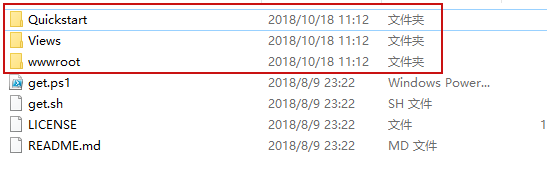
复制完后项目如下: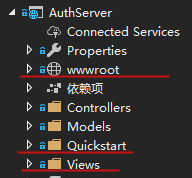
二、新建MVC客户端,命名为MvcClient
(1)设置端口为5002。
修改Start.cs的ConfigureServices方法为:
public void ConfigureServices(IServiceCollection services)
{
services.Configure<CookiePolicyOptions>(options =>
{
// This lambda determines whether user consent for non-essential cookies is needed for a given request.
options.CheckConsentNeeded = context => true;
options.MinimumSameSitePolicy = SameSiteMode.None;
}); services.AddMvc(); JwtSecurityTokenHandler.DefaultInboundClaimTypeMap.Clear(); services.AddAuthentication(options =>
{
options.DefaultScheme = "Cookies";
options.DefaultChallengeScheme = "oidc";
})
.AddCookie("Cookies", options =>
{
//无权限,显示的页面
options.AccessDeniedPath = "/Authorization/AccessDenied";
})
.AddOpenIdConnect("oidc", options =>
{
options.SignInScheme = "Cookies"; options.Authority = "http://localhost:5000";
options.RequireHttpsMetadata = false; options.ClientId = "mvc";
options.ResponseType = "code id_token";
options.Scope.Clear();
options.Scope.Add("openid");
options.Scope.Add("profile");
//options.Scope.Add("roles"); options.SaveTokens = true;
options.ClientSecret = "secret";
options.GetClaimsFromUserInfoEndpoint = true; //options.ClaimActions.MapUniqueJsonKey("role", "role"); //options.TokenValidationParameters = new TokenValidationParameters
//{
// NameClaimType = JwtClaimTypes.GivenName,
// RoleClaimType = JwtClaimTypes.Role
//};
});
}
AddAuthentication方法来添加和配置身份认证中间件。这里使用Cookie作为验证用户的首选方式,而DefaultScheme = "Cookies",这个"Cookies"字符串是可以任意填写的,只要与后边的一致即可。但是如果同一个服务器上有很多应用的话,这个Scheme的名字不能重复。
DefaultChanllangeScheme设为"oidc", 这个名字与后边配置OpenIdConnect的名字要一样. 当用户需要登陆的时候, 将使用的是OpenId Connect Scheme。
AddCookie其参数是之前配置的DefaultScheme名称,这配置了Cookie的处理者,并让应用程序为我们的DefaultScheme启用了基于Cookie的身份认证。一旦ID Token验证成功并且转化为Claims身份标识后,这些信息就将会保存于被加密的Cookie里。
AddOpenIdConnect方法添加了对OpenID Connect流程的支持,它让配置了用来执行OpenId Connect 协议的处理者。这个处理者会负责创建身份认证请求,Token请求和其它请求,并负责ID Token的验证工作。它的身份认证scheme就是之前配置的"oidc",它的意思就是如果该客户端的某部分要求身份认证的时候,OpenID Connect将会作为默认方案被触发(因为之前设置的DefaultChallengeScheme是"oidc", 和这里的名字一样)。
SignInScheme和上面的DefaultScheme一致,它保证身份认证成功的结果将会被保存在方案名为"Cookies"的Cookie里。
Authority就是Identity Provider的地址。
ClientId和Secret要与IdentityProvider里面的值一样。
请求的Scope有openid和profile,其实中间件默认也包括了这些scope,但是写出来更明确一些。
SaveTokens=true,表示允许存储从Identity Provider那里获得的tokens。
(2)修改Configure方法为:
public void Configure(IApplicationBuilder app, IHostingEnvironment env)
{
if (env.IsDevelopment())
{
app.UseDeveloperExceptionPage();
}
else
{
app.UseExceptionHandler("/Home/Error");
} app.UseAuthentication(); app.UseStaticFiles();
app.UseMvcWithDefaultRoute();
}
(3)然后对HomeController加上身份验证。[Authorize]

(4)再修改About的页面,显示User的Claim信息。
@{
ViewData["Title"] = "About";
}
<h2>@ViewData["Title"]</h2>
@*<dt>Access Token</dt>
<dd>@ViewData["AccessToken"]</dd>*@
<dl>
@foreach (var claim in User.Claims)
{
<dt>@claim.Type</dt>
<dd>@claim.Value</dd>
}
</dl>
(5)现在,可以运行AuthServer和MvcClient项目了。
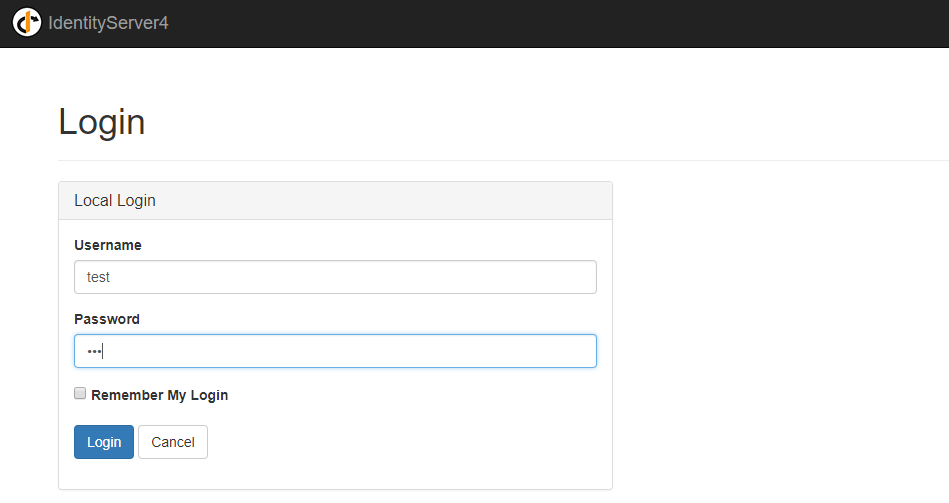
(6)输入Config文件中的TestUser的用户,密码都设为123,点击Login
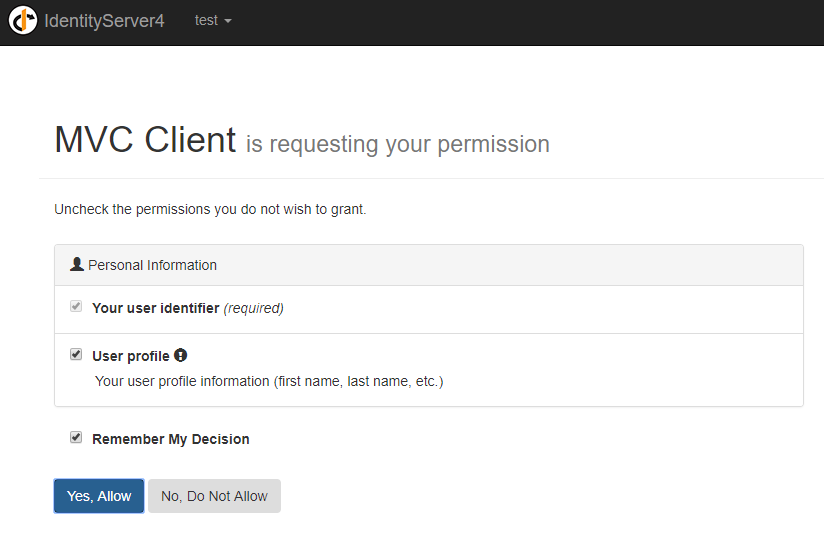
允许授权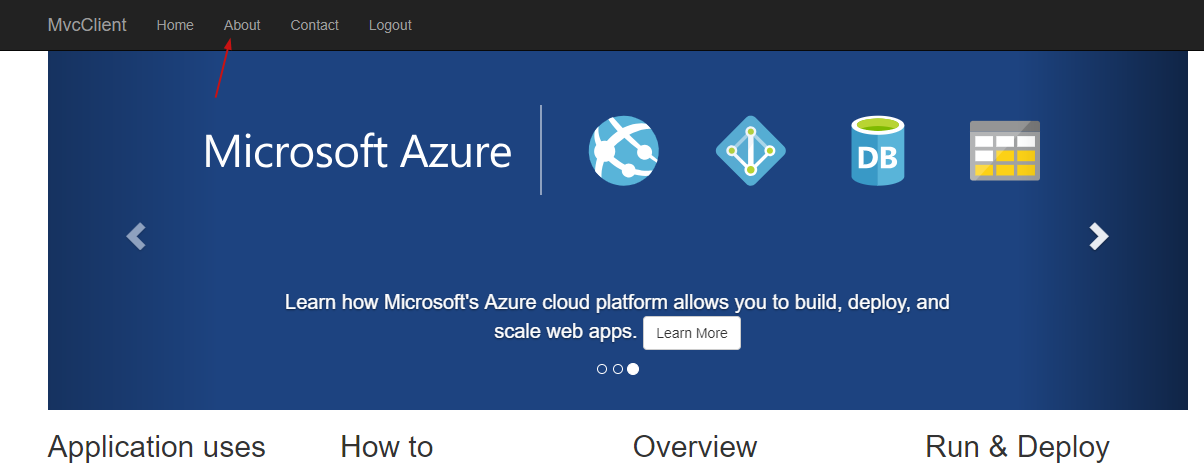
查看About页面,显示了user相关的claim信息。
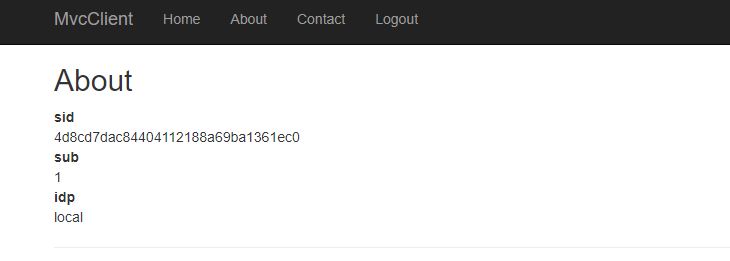
(7)当然,登出功能还没实现,这里先实现登出。打开图中cshtml文件
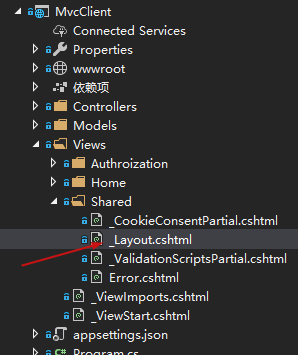
添加如下代码:
@if (User.Identity.IsAuthenticated)
{
<li><a asp-area="" asp-controller="Home" asp-action="Logout">Logout</a></li>
}

然后在HomeController控制器中添加Logout方法
public async Task Logout()
{
await HttpContext.SignOutAsync("Cookies");
await HttpContext.SignOutAsync("oidc");
}
首先要清除本地的Cookie,这个Cookie的名字要与之前配置的默认方案里的名字一致,这一步就相当于登出MVC客户端。
后一行代码的作用是跳转回到Identity Provider,然后用户可以继续登出IDP, 也就是IDP会清除它的Cookie。
(8)接着在AuthServer中的Quickstart/Account/AccountOptions实现自动跳转回登录页面。

好了,登录登出实现完了,我们接着实现Claim权限限制。
三、为MVC客户端设置Claim身份验证
(1)添加TestUser的Claim中Type为role
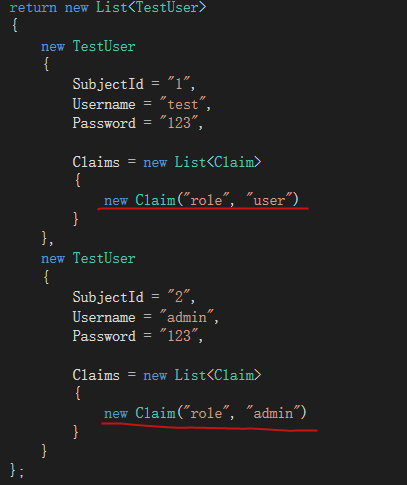
(2)定义用户信息scope的role信息

第一个参数是scope的名字,第二个参数是scope的显示名,第三个参数是它所包含的claim类型,这里就是“role”。
(3)然后还需要客户端允许请求“roles”这个scope
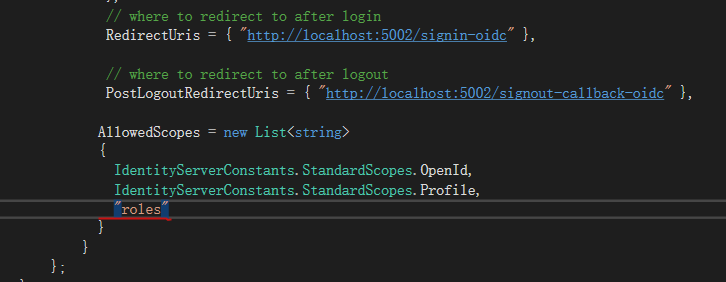
(4)MVC客户端的配置,打开MVC的startup,添加“roles”这个scope:options.Scope.Add("roles");
把role claim 映射到User.Claims里:options.ClaimActions.MapUniqueJsonKey("role", "role");
role claim映射成ASP.NET Core MVC可以识别的角色Roles。
options.TokenValidationParameters = new TokenValidationParameters
{
NameClaimType = JwtClaimTypes.GivenName,
RoleClaimType = JwtClaimTypes.Role
};
这样MVC中的role就可以识别User.Claims的role了。
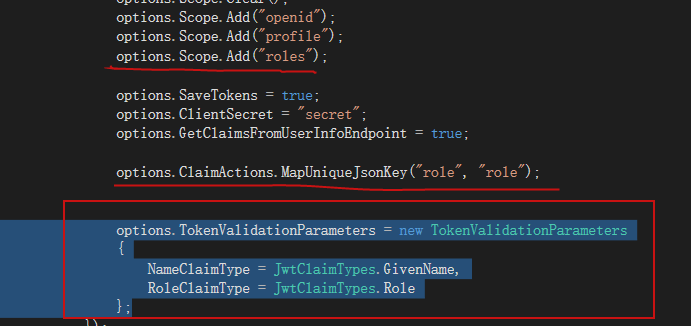
(6)最后在MvcClient项目HomeController中 About前,加上role为admin身份验证。[Authorize(Roles ="admin")]

然后运行,先用test账号登录进行验证。
发现点About页面没有权限进不去
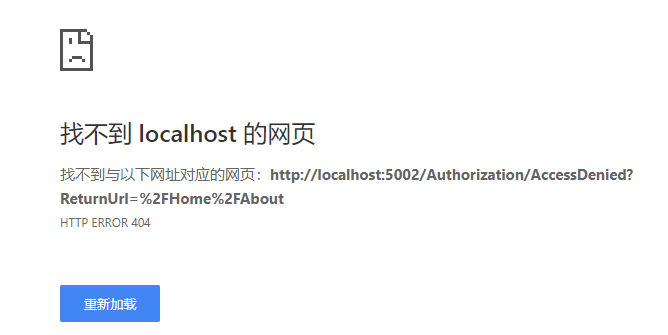
然后登出,换admin账号登录
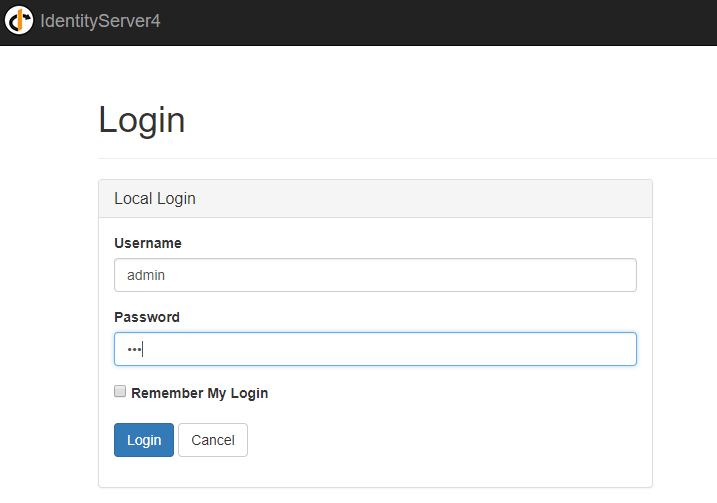
User.Claims的role成功被MVC中角色role识别,展示About页面。
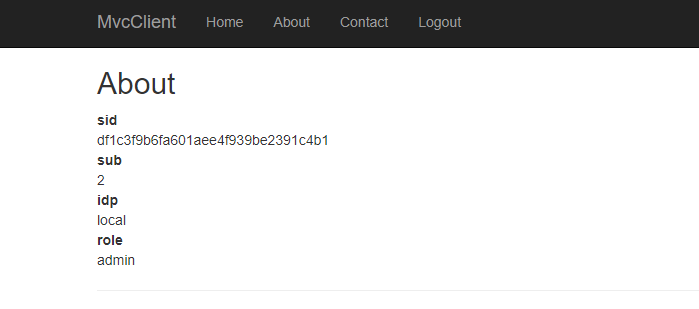
这节主要介绍Hybrid在MVC下的使用,包括User的登录登出和Claim对MVC的身份授权。
然而,这只是针对内存用户TestUser进行操作的,显示实际项目中不能满足我们需求。下节将在本节的基础上介绍如何实现IdentityServer4从数据库获取User进行验证并对Claim进行身份验证。
参考博客: https://www.cnblogs.com/cgzl/p/9268371.html
源码地址:https://github.com/Bingjian-Zhu/Mvc-HybridFlowV0.git
从Client应用场景介绍IdentityServer4(四)的更多相关文章
- 从Client应用场景介绍IdentityServer4(五)
原文:从Client应用场景介绍IdentityServer4(五) 本节将在第四节基础上介绍如何实现IdentityServer4从数据库获取User进行验证,并对Claim进行权限设置. 一.新建 ...
- 从Client应用场景介绍IdentityServer4(一)
原文:从Client应用场景介绍IdentityServer4(一) 一.背景 IdentityServer4的介绍将不再叙述,百度下可以找到,且官网的快速入门例子也有翻译的版本.这里主要从Clien ...
- 从Client应用场景介绍IdentityServer4(二)
原文:从Client应用场景介绍IdentityServer4(二) 本节介绍Client的ClientCredentials客户端模式,先看下画的草图: 一.在Server上添加动态新增Client ...
- 从Client应用场景介绍IdentityServer4(三)
原文:从Client应用场景介绍IdentityServer4(三) 在学习其他应用场景前,需要了解几个客户端的授权模式.首先了解下本节使用的几个名词 Resource Owner:资源拥有者,文中称 ...
- Android bluetooth介绍(四): a2dp connect流程分析
关键词:蓝牙blueZ A2DP.SINK.sink_connect.sink_disconnect.sink_suspend.sink_resume.sink_is_connected.sink_ ...
- 消息中间件activemq的使用场景介绍(结合springboot的示例)
一.消息队列概述 消息队列中间件是分布式系统中重要的组件,主要解决应用耦合,异步消息,流量削锋等问题.实现高性能,高可用,可伸缩和最终一致性架构.是大型分布式系统不可缺少的中间件. 目前在生产环境,使 ...
- Redis 中 5 种数据结构的使用场景介绍
这篇文章主要介绍了Redis中5种数据结构的使用场景介绍,本文对Redis中的5种数据类型String.Hash.List.Set.Sorted Set做了讲解,需要的朋友可以参考下 一.redis ...
- JavaWeb_(Mybatis框架)主配置文件介绍_四
系列博文: JavaWeb_(Mybatis框架)JDBC操作数据库和Mybatis框架操作数据库区别_一 传送门 JavaWeb_(Mybatis框架)使用Mybatis对表进行增.删.改.查操作_ ...
- SharePoint Server 2013开发之旅(一):新的开发平台和典型开发场景介绍
我终于开始写这个系列文章,实际上确实有一段时间没有动笔了.最近重新安装了一套SharePoint Server 2013的环境,计划利用工作之余的时间为大家写一点新的东西. SharePoint Se ...
随机推荐
- 【习题 3-11 UVA - 1588】Kickdown
[链接] 我是链接,点我呀:) [题意] 在这里输入题意 [题解] 模拟一下就好 一位一位地往右移动. [代码] #include <bits/stdc++.h> using namesp ...
- 【BZOJ 2119】股市的预测
[链接]h在这里写链接 [题意] 给你一个长度为n的数组a[] 设b[i] = a[i+1]-a[i]; 然后让你在b[i]里面找ABA的形式. 这里B的长度要求为m; ...
- OCulus Rift 游戏开发六原则
本文章由cartzhang编写,转载请注明出处. 所有权利保留. 文章链接:http://blog.csdn.net/cartzhang/article/details/46685477 作者:car ...
- 2015第30周四Java日志组件
Java 日志 API 从功能上来说,日志 API 本身所需求的功能非常简单,只需要能够记录一段文本即可.API 的使用者在需要进行记录时,根据当前的上下文信息构造出相应的文本信息,调用 API 完成 ...
- php 微信支付企业付款
1.所需参数 字段名 变量名 必填 示例值 类型 描述 公众账号appid mch_appid 是 wx8888888888888888 String 公众号的appId 商户号 mchid 是 19 ...
- 【29.27%】【hdu 5908】Abelian Period
Time Limit: 2000/1000 MS (Java/Others) Memory Limit: 262144/131072 K (Java/Others) 问题描述 设SS是一个数字串,定义 ...
- 【42.59%】【codeforces 602A】Two Bases
time limit per test1 second memory limit per test256 megabytes inputstandard input outputstandard ou ...
- 最全面的iOS和Mac开源项目和第三方库汇总
标签: UI 下拉刷新 EGOTableViewPullRefresh – 最早的下拉刷新控件. SVPullToRefresh – 下拉刷新控件. MJRefresh – 仅需一行代码就可以为UIT ...
- php模拟post提交文件图片等
<?php /** * Email net.webjoy@gmail.com * author jackluo * 2014.11.21 * */ //* function curl_post( ...
- [Java][web]利用Spring随时随地获得Request和Session
利用Spring随时随地获得Request和Session 一.准备工作: 在web.xml中加入 <listener> <listener-class> org.spring ...
